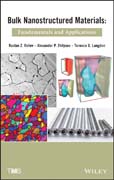
Bulk Nanostructured Materials
Valiev, Ruslan Z.
Zhilyaev, Alexander P.
Langdon, Terence G.
This book presents the most recent results in the area of bulk nanostructured materials and new trends in their severe plastic deformation (SPD) processing, where these techniques are now emerging from the domain of laboratory–scale research into the commercial production of various bulk nanomaterials. Special emphasis is placed on an analysis of the effect of nanostructures in materials fabricated by SPD on mechanical properties (strength and ductility, fatigue strength and life, superplasticity) and functional behavior (shape memory effects, magnetic and electric properties), as well as the numerous examples of their innovative applications. There is a high innovation potential for industrial applications of bulk nanomaterials for structural use (materials with extreme strength) as well as for functional applications such as nanomagnets, materials for hydrogen storage, thermoelectric materials, superconductors, catalysts, and biomedical implants. INDICE: Preface xiii Acknowledgments xv 1. Introduction 1 2. Description of Severe Plastic Deformation (SPD): Principles and Techniques 6 2.1. A Historical Retrospective of SPD Processing 6 2.2. Main Techniques for Severe Plastic Deformation 8 2.3. SPD Processing Regimes for Grain Refinement 15 2.4. Types of Nanostructures from SPD 16 PART One High–Pressure Torsion 23 3. Principles and Technical Parameters of High–Pressure Torsion 25 3.1. A History of High–Pressure Deformation 25 3.2. Definition of the Strain Imposed in HPT 28 3.3. Principles of Unconstrained and Constrained HPT 32 3.4. Variation in Homogeneity Across an HPT Disk 33 3.4.1. Developing a Pictorial Representation of the Microhardness Distributions 33 3.4.2. Macroscopic Flow Pattern During HPT 38 3.4.3. Occurrence of Nonhomogeneity in the Microstructures Produced by HPT 52 3.5. Influence of Applied Load and Accumulated Strain on Microstructural Evolution 67 3.6. Influence of Strain Hardening and Dynamic Recovery 71 3.7. Significance of Slippage During High–Pressure Torsioning 76 3.8. Models for the Development of Homogeneity in HPT 81 4. HPT Processing of Metals, Alloys, and Composites 88 4.1. Microstructure Evolution and Grain Refinement in Metals Subjected to HPT 88 4.1.1. Microstructure and Grain Refinement in fcc and bcc Pure Metals 88 4.1.2. Allotropic Transformation in HCP Metals as Mechanism of Grain Refinement 97 4.1.3. Significance of the Minimum Grain Size Attained Using HPT 103 4.1.4. Microtexture and Grain Boundary Statistics in HPT Metals 107 4.2. Processing of Solid Solutions and Multiphase Alloys 112 4.2.1. High–Pressure Torsion of Solid Solutions 112 4.2.2. Grain Refinement During Processing of Multiphase Alloys 119 4.2.3. Amorphization and Nanocrystallization of Alloys by HPT 126 4.3. Processing of Intermetallics by HPT 130 4.4. Processing of Metal Matrix Composites 136 5. New Approaches to HPT Processing 152 5.1. Cyclic Processing by Reversing the Direction of Torsional Straining 152 5.2. Using HPT for the Cold Consolidation of Powders and Machining Chips 173 5.3. Extension of HPT to Large Samples 180 PART TWOE qual Channel Angular Pressing 191 6. Development of Processing Using Equal–Channel Angular Pressing 193 6.1. Construction of an ECAP/ECAE Facility 193 6.2. Equal–Channel Angular Pressing of Rods, Bars, and Plate Samples 195 6.3. Alternative Procedures for Achieving ECAP: Rotary Dies, Side–Extrusion, and Multipass Dies 198 6.4. Developing ECAP with Parallel Channels 201 6.5. Continuous Processing by ECAP: From Continuous Confined Shearing, Equal–Channel Angular Drawing and Conshearing, to Conform Process 204 7. Fundamental Parameters and Experimental Factors in ECAP 215 7.1. Strain Imposed in ECAP 215 7.2. Processing Routes in ECAP 219 7.3. Shearing Patterns Associated with ECAP 221 7.4. Experimental Factors Influencing ECAP 223 7.4.1. Influence of the Channel Angle and the Angle of Curvature 223 7.4.2. Influence of the Pressing Speed and Temperature 229 7.5. Role of Internal Heating During ECAP 232 7.6. Influence of a Back Pressure 234 8. Grain Refinement in Metallic Systems Processed by ECAP 239 8.1. Mesoscopic Characteristics After ECAP 240 8.2. Development of an Ultrafine–Grained Microstructure 244 8.3. Factors Governing the Ultrafine Grain Size in ECAP 253 8.4. Microstructural Features and Texture After ECAP 256 8.5. Influence of ECAP on Precipitation 262 8.6. Pressing of Multiphase Alloys and Composites 266 8.6.1. Multiphase Alloys 267 8.6.2. Metal Matrix Composites 270 8.7. Consolidation by ECAP 275 8.8. Post–ECAP Processing 277 PART THRE Fundamentals and properties of materials after SPD 289 9. Structural Modeling and Physical Properties of SPD–Processed Materials 291 9.1. Experimental Studies of Grain Boundaries in BNM 293 9.2. Developments of Structural Model of BNM 309 9.3. Fundamental Parameters and Physical Properties 312 9.3.1. Curie Temperature and Magnetic Properties 313 9.3.2. Debye Temperature and Diffusivity 315 9.3.3. Electroconductivity 320 9.3.4. Elastic Properties and Internal Friction 323 10. Mechanical Properties of BNM at Ambient Temperature 331 10.1. Strength and Superstrength 332 10.2. Plastic Deformation and Ductility 338 10.3. Fatigue Behavior 345 10.4. Alternative Deformation Mechanisms at Very Small Grain Sizes 350 11. Mechanical Properties at High Temperatures 357 11.1. Achieving Superplasticity in Ultrafine–Grained Metals 359 11.1.1. Superplasticity after Processing by HPT 360 11.1.2. Superplasticity after Processing by ECAP 364 11.2. Effects of Different ECAP Processing Routes on Superplasticity 370 11.3. Developing a Superplastic Forming Capability 375 11.4. Cavitation in Superplasticity After SPD 378 11.5. Future Prospects for Superplasticity in Nanostructured Materials 380 12. Functional and Multifunctional Properties of Bulk Nanostructured Materials 387 12.1. Corrosion Behavior 388 12.2. Wear Resistance 390 12.3. Enhanced Strength and Conductivity 393 12.4. Biomedical Behavior of Nanometals 396 12.5. Enhanced Magnetic Properties 398 12.6. Inelasticity and Shape–Memory Effects 402 12.7. Other Functional Properties 405 12.7.1. Enhanced Reaction Kinetics 405 12.7.2. Radiation Resistance 407 12.7.3. Thermoelectric Property 408 PART FOUR Innovation Potential and Prospects for SPD applications 415 13. Innovation Potential of Bulk Nanostructured Materials 417 13.1. Nanotitanium and Ti Alloys for Medical Implants 417 13.2. Nanostructured Mg Alloys for Hydrogen Storage 420 13.3. Micro–Devices from BNM 423 13.4. Innovation Potential and Application of Nanostructured Al Alloys 423 13.5. Fabrication of Nanostructured Steels for Engineering 425 14. Conclusions 434 Index 436
- ISBN: 978-1-118-09540-9
- Editorial: John Wiley & Sons
- Encuadernacion: Cartoné
- Páginas: 456
- Fecha Publicación: 25/11/2013
- Nº Volúmenes: 1
- Idioma: Inglés
